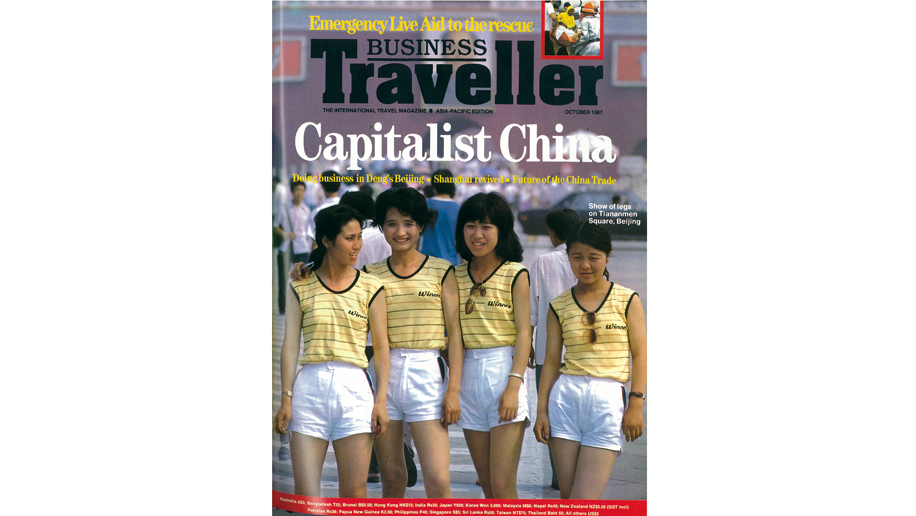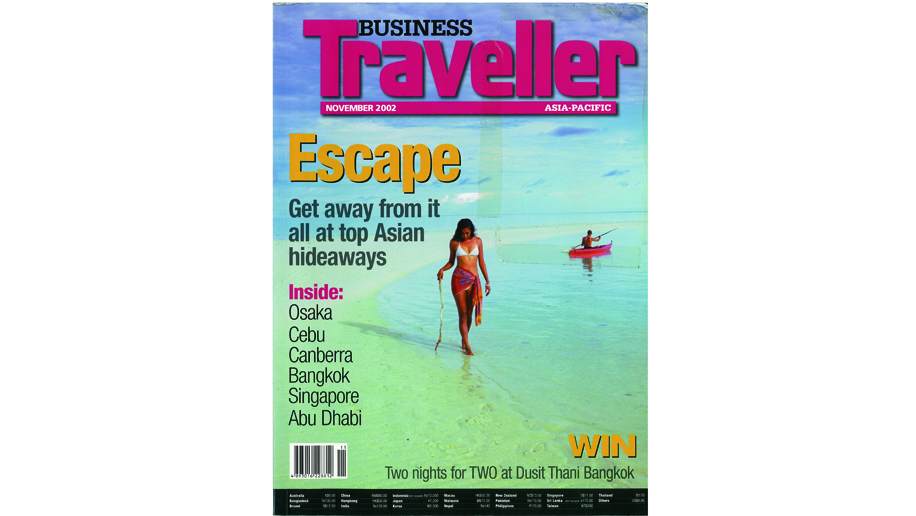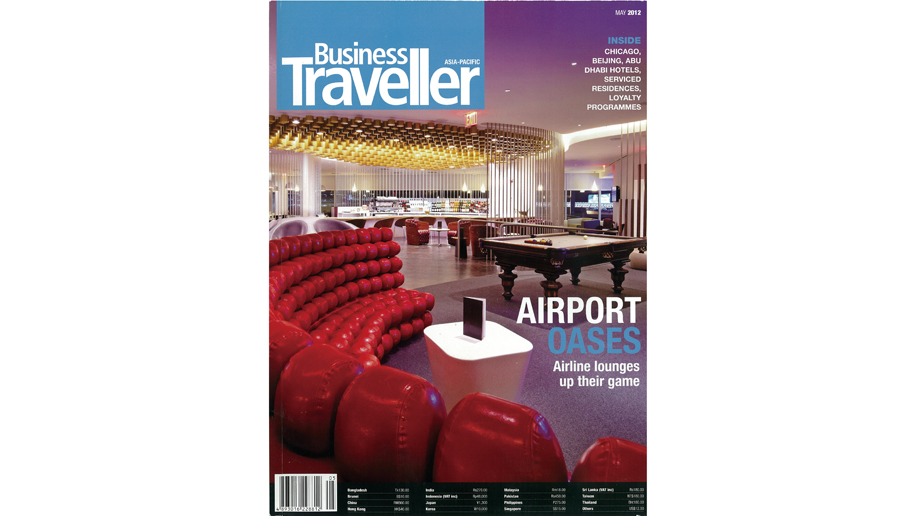
Three and a half decades is a fair amount of time to be reporting on a specific industry – especially one as diverse and far-reaching as business travel. The resulting compendium of information and knowledge provided by 35 years’ worth of Business Traveller Asia-Pacific (BTAP) yearbooks tells a fascinating tale of how corporate travel has evolved – and the Asia-Pacific region grown and come of age – since the early 1980s.
By highlighting the most significant stories from each year, a brief but illuminating overview of that evolution emerges. Read on to see what elements of the corporate travel experience remain unchanged, and which factors have been transformed beyond recognition.

1982
When BTAP was launched, the world was a very different place for business travellers in Asia – something the magazine’s style and substance clearly reflected. Images took a back seat to dense text laid out in the traditional 1970s and 80s journal format. The inaugural edition carried a feature on the issue of smoking on aeroplanes – and the fist fights that often occurred as a result. Sexism was, unfortunately, rife – but entirely unremarkable given the period.
1983
As it hit its straps, BTAP developed regular sections designed to help businessmen travelling to far-flung, exotic destinations about which little was known. “Insider’s Guides” were popular – among them one on the emergent Gulf states – while the July issue carried a full comparison of business class products from the likes of Cathay Pacific, Japan Airlines, Singapore Airlines and Thai Airways.
1984
Finding affordable hotel rooms was a frequent subject of discussion during this time, as were airline baggage allowances and excess fees. We saw the first of many features on China’s CAAC and its derivative airlines, and an interesting story asked in-flight crew members who were the best passengers… apparently Americans and British were the most polite, Japanese the easiest to please, while Aussies drank too much and became unruly, and Indians were very demanding.
1985
Major features included fire safety in hotels; the pros and cons of vaccinations; efficient bag packing; and a business class roundup complete with a full table of comparisons. However, by far the most significant story introduced the “take-anywhere wonder machine” that was the “portable computer”. A recommended example was the Hewlett-Packard Portable Plus, which looked more like an electric typewriter than today’s laptops, weighed in at 4kg and cost US$2,650.
1986
In response to a wave of hijackings and bombings, the April issue focused on airport security – sadly something that has needed regular reporting ever since. Travel insurance was also a topical issue, while features on Asian stewardesses and where to find the best “raunchy” bars and clubs in Asia’s cities perpetuated the view that business travel in the 80s went hand in hand with sleazy after-work activity.

1987
“Hotel 2001” looked to the future of hotel rooms, predicting infra-red bath taps and video checkout through your TV… However, according to the article, “not one hotel chain considers a future for automated check-ins – the personal welcome is too important.” Elsewhere, an “Insider’s Guide to Manila” reported on the Philippine capital one year on from the fall of President Marcos; and the relaxing of the political atmosphere in Deng Xiaoping’s “Capitalist China” resulted in a report on how to “negotiate the China maze”.
1988
Australia’s 200th anniversary provided good reason to discuss its great potential but a relative shortfall in business travel. Smoking on board planes continued to ignite heated debate, with smoking sections at the back being slowly reduced; credit card fraud was a hot topic around the region; and Hong Kong’s building boom meant broader accommodation options – to the relief of regular corporate visitors.
1989
In Beijing the hotel sector was blossoming… until July and the Tiananmen incident. In his editorial, BTAP publisher Vijay Verghese wrote: “As cavalcades of foreign businessmen and tourists raced to get out… the question on everyone’s lips must have been: is China worth the risk? The easy answer is no. But that is missing the point. Closed doors shut out influence, information and opportunity. Condemning a fifth of the world’s population – and its biggest potential market – to enforced isolation would be a tragedy on an even greater scale than Tiananmen.”
Elsewhere there were reports on new airline safety technology including stronger seats, fire-resistant neoprene upholstery and floor-level lighting; and a story on computer reservations systems – which apparently “will never make the travel agent obsolete”.
1990
After the fall of the Berlin Wall the magazine reported on new business opportunities in Eastern Europe, and Burma’s (Myanmar’s) first multi-party election in almost three decades posed the question “is change finally happening?” for the beleaguered nation. A welcome feature on the introduction by some hotels of “women-only” floors put the spotlight on the risks and travails for female corporate travellers, whose numbers were slowly increasing but who were still often marginalised and patronised by their male counterparts.
1991
A trending story explored the big hotel groups’ creation of new luxury brands – Asia’s booming economies were entering a golden period and everyone was chasing custom from top-end travellers. Another hot topic was new technology beginning to bridge the communications gap, with many wondering if it would mean fewer trips or even make business travel redundant. In August a prescient piece on Moscow and doing business “behind the curtain” came just before the dissolution of the Soviet Union, while a full business class survey of 32 airlines revealed that no fully flat beds were yet available, with American offering the best recline angle of just 60 degrees!

1992
BTAP’s 10th anniversary celebrated by opening its pages to readers to list their ten top travel gripes. Though many are no longer applicable today (rooms stinking of smoke, x-ray machines ruining camera film, etc), some are: a failure to enforce carry-on baggage rules; fast immigration made useless by slow baggage handling, and so forth. The June cover story addressed the rise of short-haul “feeder carriers” like Dragonair, EVA Airways, Silkair and Bangkok Airways – foreshadowing a future need for smaller airlines flying to secondary destinations throughout the region. The October issue introduced the first ever BTAP Reader Poll and Travel Awards, which involved 10,125 subscribers and newsstand readers.
1993
Saigon (Ho Chi Minh City) was given extensive coverage after the US lifted its trade embargo on Vietnam – it would feature more and more heavily in future issues as it opened up to the world. Travel gadget updates were now more frequent, as technology advanced at an exponential rate. One roundup featured a Seiko watch with pager messaging function; another foretold the move from analogue to digital cellular phones, stating that “digital lines have three times the existing capacity of their predecessors…” Video conferencing was touted as a potential slasher of travel costs, while the latest laptops now boasted colour displays, 120MB hard drives, 3.5-inch floppy disc drives and 4MB of memory. And they still cost north of US$2,000.
Meanwhile, Beijing it seems was finally improving as a business destination for foreigners; Tokyo and Hong Kong were the subject of searches to find budget accommodation; Brazil was “big, brash and beckoning”; and Dubai aspired to become an economic hub.
1994
Frequent flyer programmes were by now catching on, while business travellers were becoming more confident about using credit cards in places like China and Southeast Asia. A feature on Xiamen highlighted its potential but the need to play a waiting game for improved ties across the Taiwan Strait. A special report on airline seats reminisced that in-flight beds were commonplace on intercontinental flights until the 1960s. “Nowadays, of course, it would be unthinkable for most airlines to provide this service, since the cost would simply be unjustifiable,” said Herbert Bammer of Austrian Airlines at the time.
1995
A new wave of aircraft anticipated improved efficiency for airlines and better flying conditions for passengers, as Airbus rolled out its A330-300 and Boeing its B777. Other aviation industry developments included the inevitable move by airlines to non-smoking flights across the board. Laptop computers still looked (and weighed) like bricks, but IBM, among others, was now offering more than 1GB of hard drive space.
1996
A feature on mobile phones considered that they were “moving from being an infuriating gimmick to an invaluable business tool”, but a cost rundown showed that prices were high – a basic Hong Kong package cost HK$650 (US$85) per month for 100 free minutes. Meanwhile, an update on airlines’ first class products showed a split in strategies: the premium seating class was being dropped by Air Canada, Dragonair and Garuda Indonesia; but ANA, Air India, Cathay Pacific and Air New Zealand were all sprucing theirs up. Air France and British Airways were by now offering “fully reclining” seats in first class – though the photos showed they were still not fully flat.

1997
This year marked the much-discussed handover of Hong Kong to China. Our feature remarked: “Forget musty colonial rule and dismiss egocentric communism. This is adapt-or-perish Hongkong [sic]. It might not look, sound, smell or be pretty, but Hongkong is about one thing and one thing only: the pursuit of financial wealth.” A notable feature focused on Bangalore, which had aspirations of becoming “the subcontinent’s Silicon Valley”.
1998
This was the year of the first BTAP airline wine tasting, which would grow to become the influential Cellars in the Sky awards. The judges chose SAS’s Champagne, Asiana Airlines’ white wine and South African Airways’ red wine as the pick of the crop.
The newest laptop was a game-changer: at last we had a light, attractively designed but powerful mobile computer. And no, it wasn’t a Mac – it was the Sony Vaio. As the Asian financial crisis took a vicelike grip on the region, articles on Seoul, Taipei, etc detailed the struggle for survival.
1999
BTAP at this point was still running a regular six-page section called “Airfares”, a text- and number-heavy listing of air ticket prices around the region. However, in the March issue a story on “Travel and the Internet” explored the rise of online booking channels, noting that “it still hasn’t lived up to expectations, though the lures to do so could soon prove irresistible”. IBM travel-industry strategist David Dingley added: “For all we hear about it, the Internet is still used by relatively few people.”
Meanwhile, the creation of the Oneworld alliance drew the following remark from editor Jonathan Wall: “…codeshares can only be made to work if passengers can expect a common level of service, comfort and safety no matter which airline they’re flying with.”
2000
As worries about the Millennium Bug’s effects on computer systems came to naught, a new business class survey revealed that, finally, genuine lie-flat beds were available on British Airways and Virgin Atlantic – the rest would scramble to follow suit. Most business class products now also included noise-cancelling headphones, satellite phones and personal video screens – Emirates was offering in-seat phones and electronic seat controls. A new design for the magazine brought features on keeping fit on the road and increasing travel gadget updates – a sign of things to come, as business travel boomed in Asia in tandem with the tech revolution.
2001
The future of flying was once again under the microscope with a feature on the Airbus A-3XX, which the ambitious French aircraft manufacturer developed and eventually released as the A380. John Leaky, senior VP of Airbus, stated: “Boeing dominated the 20th century, in the same way that we hope to dominate the 21st.” (In 2000 Airbus had outsold Boeing on a dollar and unit basis.) The November issue inevitably focused on security measures that airlines and airports took after 9/11: “…proactive safety measures are the order of the day and passenger PR is set to very much take a back seat”.

2002
Features on finding great hotel deals in five-star properties, and lower fares being offered by secondary carriers like Air Asia and Cebu Pacific, seemed to foretell a tightening of collective belts for business travellers. Putting internet onto aeroplanes was being discussed but was still not realistic – though you could check your emails via the in-flight phone for a hefty price. The spotlight was also aimed at a new trend sweeping the region: high-class hotel spas offering wide selections of traditional treatments.
2003
The future of hotel design was investigated, with bigger bathrooms and – wait for it – “touch of a button technology” to look forward to. March unfortunately saw the SARS epidemic sweep through the region – subsequent reports detailed empty hotels and planes, and little inter-regional travel.
2004
The number of sporting events in Asia was rising; golf in particular was exploding in popularity, and “Golfing around” stories would become regular features. The introduction of biometrics was looming – the US demanding the introduction of chipped passports and visas to aid security post-9/11 – while bombings in the Philippines, Thailand and Indonesia resulted in severe tightening of hotel security measures, including x-ray machines and sniffer dogs. The boom in low-cost carriers – 14 airlines were now catering to rising travel in Asia – was a significant industry story.
2005
Our May issue charted the ongoing rise of the serviced apartment sector, expanding rapidly due to a new wave of long-term workers on lengthy assignments in China, etc, while a story on the “boutique hotel” gave notice of the hotel brand explosion to come over the following decade.
2006
The hotel industry was front and centre throughout the year, with a curious paucity of airline stories. Hospitality-focused features included butler services, emergency procedures, executive floors and luxury spas… it was as if we were breathing a collective sigh of relief that the tough first half-decade of the new millennium was behind us.

2007
An amusing story titled “Flight of fancy” reported on Richard Branson’s plans for “green space travel” in the Virgin Galactic spaceship by 2010 – a fanciful idea indeed. BTAP’s 25th anniversary issue pulled out all the stops, making comparisons between the overtly sexist and un-PC mindset of the 1980s and the very different attitude towards leisure pursuits in the 21st century (at least within the pages of our magazine). Other issues discussed the rise of the “heritage” hotel, and the booming Pearl River Delta.
2008
The digital world encroached further and further, with articles offering advice on protecting your devices from “electronic eavesdropping”, viruses, trojans and unauthorised access. Airports were also the subject of interest: Changi’s trendsetting Terminal 3 opened, and aviation wunderkind Dubai International Airport was proving itself a pioneer of retail and entertainment for air passengers.
2009
The year began with caution in the aftermath of an earthquake, blizzards and the melamine-milk scandal in China; riots and airport shutdowns in Bangkok; a terrorist attack in Mumbai; and let’s not forget the global financial crisis! A feature on Shenzhen showed that while other cities were coping (Singapore), downsizing (Dubai) or simply surviving (Bangkok), it was forging ahead as the manufacturing centre of the China juggernaut. Later in the year a feature on how Thailand was rebounding from civil unrest highlighted its events industry as a focus for attracting new business. The MICE industry was by now growing fast throughout the Asia region.
2010
Coverage of the Shanghai World Expo showed that this was a momentous event for China, which wanted to prove to the world that it could host a global event in spectacular style. Elsewhere in the magazine there were tips on how to get the most from frequent flyer and hotel loyalty programmes, while a feature on early mobile apps like Amadeus’s “CheckMyTrip” showed the way forward for busy execs wanting information at their fingertips. It’s fascinating to think that what we now take for granted was only really taking off around eight years ago.
2011
“The race to go green” was well and truly on now, with airlines keen to reduce carbon emissions and hotels touting their environmental credentials. OTAs and other travel websites were “sounding the death knell for shopfront travel agents”, while an investigation into new technology for airports predicted that RFID bag tags, self-service bag drops and location-aware baggage would be common by 2014, and 2015-2020 would see the implementation of “personalised promotions based on passenger preferences” and “Near Field Communication phones that allow mobile payments”. The article ended thus: “It is no longer a case of whether or not [airports and airlines] will automate, but when and how fast.”

2012
The magazine’s coverage of China was ramped up as its second- and third-tier cities boomed, opening their doors to multinational companies. “Inside China” articles covered cities like Xiamen, Chongqing and Xian, which had changed beyond recognition over the previous decade. Private jet companies turned to Asia for opportunities as Europe and the US continued to struggle economically – according to one article, “an average of 100 jets per year will be delivered to Greater China in the coming decade”.
2013
Gadget reviews became more prominent as tech offerings and capabilities reached bewildering heights. Articles covered subjects such as the best travel apps, the latest cellphone and laptop models, and the pros and cons of user review sites such as Tripadvisor, etc. The risk of lithium-ion batteries on board aircraft was just a small hiccup in the speeding technology train. All hail the arrival of the digital world!
2014
A heavy focus on China was indicative of the country’s economic dominance and the concentration of interest from travel industry players. We also reported on increasing ties between Asia and Australia; playing the “loyalty game” to get the most from your airline alliance membership; and Asean’s obstacle-beset “Open Skies Policy”. Of particular interest to readers was an in-depth rundown of two exciting new-generation aircraft that promised to transform the in-flight experience: Boeing’s B787 “Dreamliner” and the Airbus A350.
2015
A report on the Shanghai Pilot Free Trade Zone, launched in 2013 with the aim of making the city a global financial centre, explained why it was not as successful as anticipated (to the relief of Hong Kong). There was renewed interest in premium economy seats – “a lucrative opportunity for airlines to capture the business of corporate travellers with clipped wings (aka budgets) and leisure travellers with a desire for more comfort.” A welcome shift of focus also saw articles on encouraging growth in Indonesia, Malaysia and Thailand.
2016
Sadly, a rise in civil conflict and terrorism across the world in 2015 meant a renewed focus on security and travel restrictions. This didn’t slow Asia down, though, as we highlighted 88 brand-new Asia-Pacific hotels. Myanmar finally opening up after so long in the political and economic wilderness caused excited ripples in the business community, but probably the biggest story of the year was that of the hotel “super-mergers”, with Marriott subsuming Starwood, and Accorhotels acquiring FRHI. The consequences for the competition – and customers themselves – are yet to be fully realised.
2017
And so we come to the present day. We’ve covered Macau’s reinvention of itself from casino den to leisure and lifestyle destination; Chinese aviation – which can now boast 48 airlines of its own; and how corporate travellers increasingly employ sharing economy channels like Airbnb in their travel itineraries.
If there’s a single element of our industry that has transformed it more drastically than any other, it is the digital universe. For better or worse, it has taken over virtually every aspect of business travel today.












